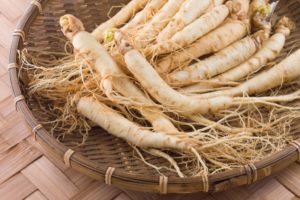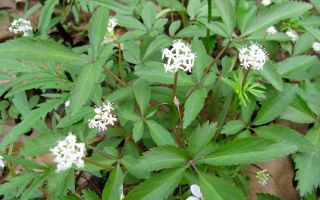Content
- 1 What does ginseng look like and where does it grow?
- 2 Chemical composition
- 3 Why is ginseng useful?
- 4 The use of ginseng in traditional medicine
- 5 Traditional medicine recipes based on ginseng
- 6 Ginseng in home cosmetology
- 7 Ginseng face masks
- 8 Ginseng for hair health
- 9 Harm of ginseng and contraindications
- 10 Collection, preparation and storage of ginseng
- 11 Conclusion
- 12 Reviews
Ginseng is known as a valuable medicinal plant listed in the Red Book: the collection of ginseng for medicinal purposes is strictly regulated by law. Such close attention to an inconspicuous, at first glance, perennial plant is explained by the uniqueness of its beneficial properties. It has long been successfully used in the treatment of many diseases, could be used internally and externally. The beneficial properties and contraindications of ginseng directly depend on the influence of chemical elements that are contained in parts of plants.
What does ginseng look like and where does it grow?
Habitats of this species: Primorsky Krai, all parts of the Far East. It can grow in some provinces of China, it is found on the plateaus of North Korea. Few can recognize the plant up close. The fact is that the pharmaceutical industry and manufacturers of cosmetics use pomace from ginseng roots, as well as extract of leaves or fruits. The aerial portion of ginseng looks inconspicuous.
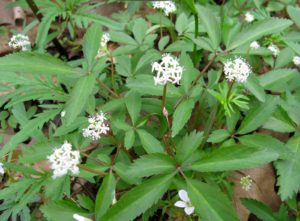
This is a small green plant with a dense, stable stem, its height rarely reaches a maximum mark of 60 cm. The leaves have 5 ends, grow rosettes upwards. The real flowering of ginseng can be seen in the middle of summer: it blooms with small white or pink flowers, which are collected in simple umbrella-shaped inflorescences. The peculiarity of the appearance of ginseng appears when the fruits begin to ripen. In August or September, small red fruits appear on the tops of the bright green leaves. They are glossy and contain seeds inside.
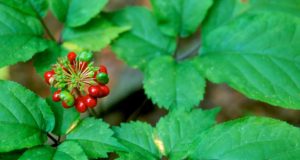
Chemical composition
Eastern legends say that the roots of ginseng were used for various attempts to create an elixir of youth. These actions can be explained by the unique properties of the components of its composition.
The difference between ginseng and many other medicinal plants in the content of the full spectrum of triterpene glycosides. In second place in importance are essential oils, which have a beneficial effect on all systems of the human body. Vitamins are represented by various types:
- B 1;
- B 2;
- ascorbic, pantothenic, folic acid.
The root contains an increased content of pectin, starch, sucrose, tannins, alkaloids, fatty polyunsaturated acids, and useful mucus.
Ginseng can be a source of macro and micronutrients. It contains phosphorus, iron, manganese and sulfur, as well as compounds of silicon, molybdenum, cobalt, magnesium and zinc.
The chemical composition of the plant does not depend on the time of collection or age. The complex of substances is stored in the roots and leaves throughout its existence.
Why is ginseng useful?
The benefits and harms of ginseng are determined by the degree of its effect on human health.
The literal translation of the name from the Chinese language means "the root of life", the spread of this name is not accidental. The properties of the plant are unique: they are actively used in pharmacology, cosmetology, and folk medicine.Ginseng can be useful as a medicine and as a dietary supplement for disease prevention.
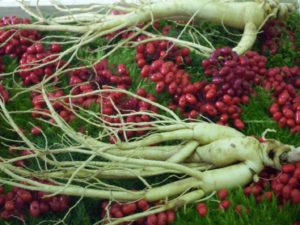
Researchers who are asking questions about the benefits and harms of plants for humans have identified several main properties of ginseng root:
- Promote cleansing of the body. The content of tannins, alkaloids, tandem of vitamins and amino acids in the root activates the functions of the digestive system. The complex of minerals helps to more actively absorb food, process it and remove toxins. This property is often used in the preparation of weight loss programs.
- To normalize the condition of the skin, hair, nails... The health benefits of ginseng root for women are undeniable. The presence of B vitamins, their combination with useful micro-, macroelements and amino acids creates a positive effect that affects the state of the epidermis. The plant is able to activate blood flow, which leads to active cell regeneration. That is why pomace of ginseng root is often found in cosmetic products, it is added to complexes for the care of age and problem skin. On its basis, shampoos and balms are produced, which help to improve the appearance of hair, relieve inflammation and itching of the scalp
- Have a positive effect on the cardiovascular system... The "root of life" has the beneficial property of normalizing cholesterol levels. This mechanism is considered to prevent the formation of blood clots and atherosclerotic plaques. A feature of ginseng is its direct effect on the work of the heart muscle. The combination of the components of the root composition has a positive effect on it, strengthening and increasing its amplitude.
- Contribute to the elimination of nervous disorders... Regular intake of ginseng root in food leads to the normalization of mental health. The essential oils in the plant can help fight stress and neurological conditions.
- Provide a general strengthening effect... Doctors call ginseng a natural adaptogen. This means that plants are able to increase the body's defenses.
- Produce a tonic effect... Due to this property, ginseng root is often added to drinks that increase energy potential. On the basis of the root, tinctures are made that can increase physical strength.
- Provide a preventive effect for those with diabetes mellitus... Ginseng root is known as a regulator of high blood sugar, therefore it is recommended as a complex therapy for diabetics.
For men
Ginseng roots contribute to the normalization of the endocrine system, which affects the correct production of male hormones. The mechanism of action of ginseng is beneficial in the normalization of the reproductive system in men.
The stronger sex is recommended to use decoctions, tinctures or tea with ginseng to regulate potency. You can make your own drinks from the dried root.
For women
The benefits of ginseng for women are undeniable. Its properties in normalizing the psychological state and reducing emotional stress are used by women with the onset of menopause or premenstrual syndrome.
Correct use of ginseng root has undeniable benefits in an effort to get rid of extra pounds.
Regular intake normalizes blood pressure, improves sleep quality and positively affects the appearance of the face and hair.
Women often use extracts to make homemade recipes that can preserve and enhance beauty and health.
The use of ginseng in traditional medicine
Pharmacologists use plant root extract. The most common dosage form is ginseng tincture. Extracts are added to powders and tablets. Very often it can be found as one of the components of dietary supplements.
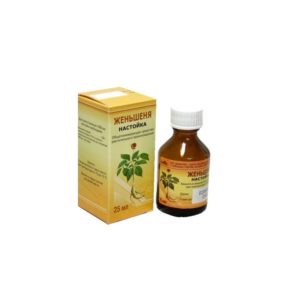
Tinctures are prescribed:
- with atherosclerosis;
- diabetes mellitus;
- violation of the thyroid gland;
- anemias.
Tablets and powders are prescribed for the elderly as a general tonic.
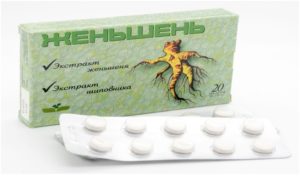
Excessive use of dosage forms can be harmful to health. The tincture contains elements of alcohol, which, if consumed excessively, can affect the quality of sleep or the functioning of the gastrointestinal tract.
Traditional medicine recipes based on ginseng
Traditional medicine is one of the parts of alternative medicine, which has a huge number of methods and methods of treating diseases, a variety of knowledge about them and assumptions about the appearance of their causes.
Ginseng parts have been used in folk medicine throughout its existence. The centuries-old experience is accompanied by the spread of a unique collection of recipes that use the undeniable benefits of ginseng for humans.
Honey extract
Ginseng honey is useful for treating several conditions:
- anemia;
- chronic fatigue;
- depression.
For 1 liter of lime-tree honey, take a small root. It is ground on a grater, poured into honey. The mixture is kept in a dark place for 2 to 3 weeks. The hood is used in 1 tbsp. l. daily for 1 month.
Ginseng paste
For the preparation of an external remedy that helps to treat skin diseases, and also works as a cosmetic agent to relieve inflammation and redness on the skin of the face, use the root.
2 tbsp. l. crushed powder is mixed with 2 tbsp. l. water, then brought in a water bath to +80 ° C. The paste is applied after it has cooled down.
Tea
To make tea, the powder is poured with boiling water, insisted, filtered, and a sweetener is added. The drink is taken in 1 - 2 tbsp. l. three times for 30 days. Ginseng tea is beneficial for nervous disorders, helps to quickly restore normal state after difficult emotional periods.
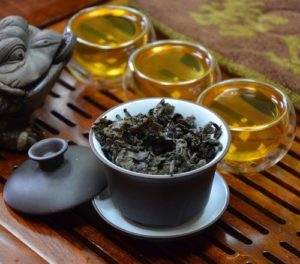
Ginseng with grape juice
The grape juice recipe uses a tincture.
Natural freshly squeezed juice of grapes is mixed in a 1: 1 ratio. Take 1 tbsp. l. 2 times daily. The effect of the drink on the body:
- helps to strengthen the immune system;
- reduces stress levels;
- evens out the hormonal background.
Ginseng in home cosmetology
The medicinal properties of the plant are widely used in home cosmetology. The extract of the "root of life" is often found in cosmetic products for the care of aging skin, this can be explained by the unique property of the plant to activate the processes of cell renewal at all levels. It is common to use ginseng root face masks or add ginseng root extract to skincare products.
Ginseng face masks
Extracts are used to whiten the skin, fight age spots and mimic wrinkles.
7 drops are mixed with 20 g of shea butter, applied in the morning to cleansed skin.
An effective remedy based on ginseng powder for eliminating inflammation on the face is a mixture of 20 g of powder and 100 milliliters of vodka.
The components are mixed, insisted for 7 days, then wipe the problem areas of the face in the morning and evening
Ginseng for hair health
The benefits of ginseng for hair lie not only in improving the condition of the hair structure, but also in the effect on the scalp. Means with ginseng relieve inflammation, eliminate dandruff.
To prevent hair loss, add a few drops of ginseng root extracts to the shampoo.
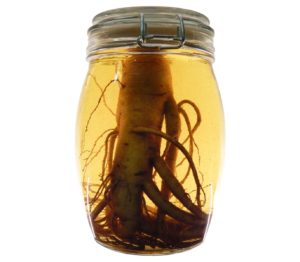
The hair mask is suitable for minimizing hair loss, increasing volume, improving structure:
- 5 drops of extract;
- yolk of 1 egg;
- 3 tbsp. l. kefir.
All components are mixed, applied to the face, left for 10 - 15 minutes, then washed off with warm water.
Harm of ginseng and contraindications
The harm from the use of ginseng root can develop with excessive use, as well as the wrong approach to the treatment of some conditions. It is not recommended:
- during pregnancy;
- during lactation;
- the presence of tumor formations;
- the development of multiple bleeding;
- during periods of exacerbation of serious chronic diseases.
Harm can be caused by the reception of infusion in cases where human activity is associated with maximum concentration of attention.
There is a risk of harm to health in case of individual intolerance to the components of the products.
Collection, preparation and storage of ginseng
Ginseng is specially grown in the Primorsky Territory, in the regions of Korea, China and Japan, as well as in Vietnam.
The peculiarities of cultivation are that the plant needs the most fertilized soil, is thermophilic and requires systematic transfer from one place of growth to another.
As a rule, ginseng roots are harvested, they are stored fresh or dried. The roots are processed before being sent for storage.
Fresh root is stored for no more than 5 days. Dried roots are stored for about 12 months in a closed container.
Conclusion
The beneficial properties and contraindications of ginseng depend on the methods of application. The unique composition makes the root of the plant especially valuable. Correct use eliminates the risk of harm to the body.
